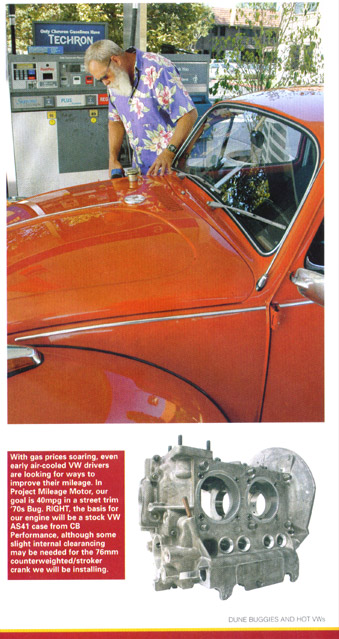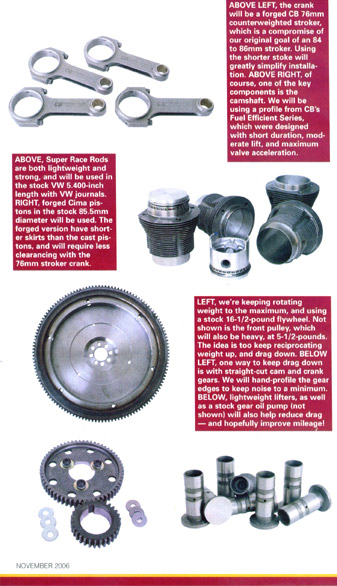|
Hot VWs - November 2006 - Project Mileage Motor - Part 1 Where do we begin to assemble an engine that will (hopefully) provide 40mpg?
Project
Mileage Master We're sure that by now many of you have been wondering when the heck the mileage motor series we have been talking about for several months would actually begin. Our original plans were to start two months ago, but... once we started compiling all the information, talking to different people with different ideas, and putting everything down on paper, well, things didn't fall into place quite as easily as we thought they would. After all, our goal was to build an air-cooled VW engine that would power a 1970ish VW Beetle Sedan, in stock trim, down the highway at 65-70mph, and deliver at least 40 miles-per-gallon. To make things even more difficult, we didn't want to use any custom one-off components that you, the reader, couldn't get so, that the same engine could be easily built in your garage with the same mileage results. Our first thoughts were to build the engine as "square" as possible, meaning that the bore and stroke are equal. However, starting with the 1600's 85.5mm bore, that meant increasing the stroke from 69mm to 84mm or 86mm. Not entirely impossible mind you, but it does start to get tricky. Since there are no 85.5 "B" stroker pistons available, a setup like this would require extremely thick spacers under the cylinders. Unless longer rods were used (requiring even thicker spacers), it would also require a massive amount of material removed from the piston skirt for clearance. The idea of a new aluminum case with raised deck came up, but for the 85.5mm bore that would end up being an expensive custom built component, and would still result in the engine being extremely wide, and difficult to install in a stock Bug without trimming metal. To simplify things, we decided to base this engine on a stock magnesium Type 1 case, with a CB Performance counter-weighted 76mm stroker crank and forged 85.5mm pistons (1745cc). Not square, but closer than stock. The forged style of pistons are being used because they have a smaller skirt, and require considerably less clearancing when used with the stroker crank. Lightweight Super Race connecting rods in the stock 5.400-inch length will be used to keep the torque range down low. As this engine is being built for maximum mileage and not performance, the rotating weight will be kept as high as possible, which means a stock weight (16 1/2 pound) flywheel as well as an extra-heavy 5 1/2 pound front pulley. Of course, the crew at CB Performance will balance everything for smooth operation prior to assembly. While we're maximizing the rotating weight, we're going to minimize drag. This means Straight Cut Cam Gears (hand-profiled edges to reduce noise), lightweight lifters, lightweight aluminum pushrods, even an oil pump with stock length gears. While head dimensions have not been finalized yet, they will be operated by a cam from CB Performance's "Fuel Efficient Series," which are designed with shorter durations, maximum valve acceleration, and moderate lift. So far this is the basis of our engine, which we eventually hope to top-off with a fuel injection system for maximum tunability. Will we reach our goal of at least 40 mpg? Impossible to say at this point. But one thing's for sure, whatever the outcome, you can be sure we'll give you the honest results of any and all modifications. Stay tuned. |
||||||||





